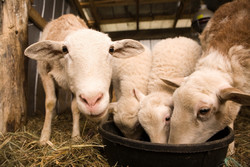Surveillance for possible health impacts of GM feed in livestock animals
GM crops grown outside Europe are often destined for several EU markets, including animal husbandry, for which they are processed into animal feed. The EU approves of using GM-derived ingredients, but only if each crop passes vigorous safety assessments. However, European regulators may still require post-market monitoring as a means of verifying pre-market assumptions. So far, this requirement has not been imposed for GM animal feeds, yet it would be useful for the regulators to be able to provide the appropriate tools and data to support such a requirement in future. The EU-funded MARLON (Monitoring of Animals for Feed-related Risks in the Long Term) project was therefore established to provide guidance for monitoring GM feed-related risks in livestock. Scientists addressed any potential links between using GM-derived feed and animal health risks by creating inventories of existing post-market monitoring initiatives and gathering data on potential animal health impacts of GM feeds from scientific literature. Project partners also collated information on measurable animal health indicators and the possibility to analyse exposure. Data collected from controlled short-term, long-term and multi-generational feeding trials revealed no adverse health effects on animals fed with GM ingredients. Some effects may even be positive, as several reports indicated, for example, that insect-resistant GM crops may contain lower levels of toxic chemicals produced by fungi that colonise insect-damaged crops. Researchers also developed IPAFEED, an open-access database that features three categories of information. They involved specific health parameters measured in animals fed on GM-derived feeds and the detectability of GM DNA and proteins in livestock based on data from scientific literature. It also included existing surveillance activities that may provide useful information for the purpose of monitoring for potential health impacts of GM feeds in partners’ Member States. In addition, the team constructed an epidemiological model. Able to evaluate the suitability of existing surveillance systems, it can detect changes in commonly measured syndromes linked to the assumed health effects of a GM crop used as feed for a specific livestock species. The model accounts for husbandry, veterinary, and monitoring practices as well as background conditions. Given that the particular GM feed, livestock species and health impact for which monitoring may be required in future are unknown, the model is generally applicable and can be used for a wide range of species, husbandry systems, and potential causes of the health impact. It is foreseen that under circumstances of particular surveillance data being unavailable or limited, expert opinions on background prevalence and severity of certain symptoms, and the likelihood of detecting changes in their prevalence, may also be solicited. These data highlighted the importance of being able to set up a post-market surveillance programme that will enable monitoring for both positive and negative trends in animal health in livestock feed with GM ingredients. By providing tools that assist in the design of effective syndromic surveillance programmes, MARLON will help inform European regulators in their decision-making process.
Keywords
Genetically modified crops, animal feed, MARLON, livestock, health impacts, open-access database



